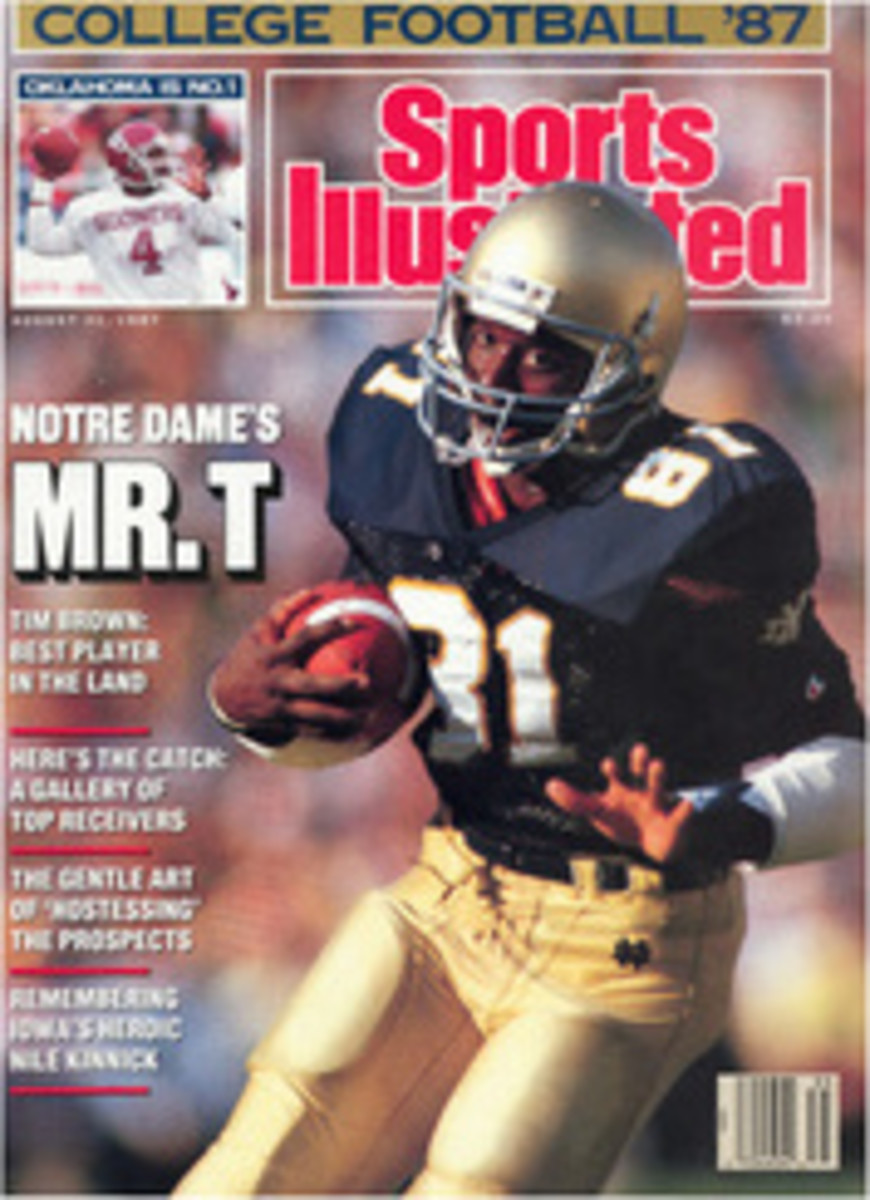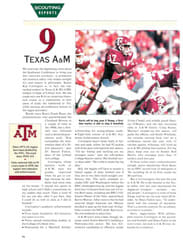
THEY FIELD TOUGH EGGHEADS IN CALTECH FOOTBALL
The California Institute of Technology's Battling Beavers are the product of a typical football factory. They would have to be to have lost only one game in the last two seasons (17-1), five in the past four seasons.
Caltech has a standard roster: 1 potential Nobel laureate, 8 grad students, 24 undergrads and 16 nonacademic members—custodians, gardeners and others—who work around the Pasadena campus or at the nearby Jet Propulsion Laboratory. The Beavers also have a couple of 50-year-olds and students from France, Wales, Japan and Pakistan, some of whom carry pocket versions of the rules. The player from Wales watched his first football game through his own face mask as he kicked extra points and field goals.
There are the customary concerns around campus about the warped priorities of big-time football: A professor fears losing a student to athletic injury more than the coach worries about losing a player to academic ineligibility. The mean combined SAT score of incoming freshmen at Caltech is 1,410, just about double the scores the NCAA requires for academic eligibility.
The coach worries about the usual things: Some of the alumni think he's winning too much. The Caltech view of athletics, according to athletic director Warren Emery, is that it's "something to do while the student is here."
Caltech players do everything they can to dispel the stereotype that they are illiterate, steroid-fed behemoths: "We take the game seriously. And the teams we play take it goddam seriously," says linebacker/cell biologist Dr. Eric Davidson. "There's a lot of pride involved. We like to hold our ground and keep them from moving the ball on us. And we like to ram the ball down their throats. Our culture has this image of eggheads that this is inconsistent with."
Caltech has the quietest campus to be associated with a winning football team in the country. Seldom, if ever, are speakers propped in the dorm windows. To most of the students, heavy metal is osmium. The serenity of a walk through the campus, amid olive trees and low mission-style buildings, belies the complexities of what goes on behind the stucco walls. Far from your mind is the thought that you're at the home of 21 Nobel Prizes. Even further from your mind is football.
The closest most people at Caltech come to football is the Rose Bowl, which is three miles away and where Caltech made perhaps its biggest splash in the game. On Jan. 2, 1961, Caltech students switched the instructions to Washington fans on which cards to hold up at what time for their card display so that at halftime the Huskies spelled out C-A-L-T-E-C-H across one side of the stadium. During the 1984 Rose Bowl game, Caltech students rigged the scoreboard so that ILLINOIS and UCLA were replaced with CALTECH and MIT.
Until four years ago, any distraction from the Caltech performance on the field was welcome. The Battling Beavers had just three winning seasons from 1932 to 1981, and over one stretch lost 35 straight games. In 1977 the football program was suspended when only 15 students tried out for the team. The next year, Caltech made football a club sport—not governed by NCAA rules—which allowed the Beavers to include graduate students and faculty on the team, and to play junior college, semipro and junior-varsity college teams.
Even with every single body on campus eligible to play and even after the success the football team has had in the past few seasons, turnout at practice still hovers between 15 and 30. Attendance for home games rarely exceeds 100. But how much Beaver fever can be expected at a school where the students are so unfamiliar with football that flyers announcing each game herald FULL CONTACT/TACKLE football?
Despite the billing, many Caltech players aren't prepared for the contact either. The equipment man has had to teach some of them how to dress. Coach Lin Parker remembers the time a player from Pakistan put his hip pads on backward: "He put the tailbone protector in front. It made more sense to him."
Not all of the students who show up in Pasadena are athletic novices. Jonathan Brown, the tailback two seasons ago, turned down football scholarships from several Division I-A schools. He quit the Beavers last year, however, to devote more time to classwork. He told a disappointed, but understanding, Parker that he had decided he would rather be Cal-tech's first black electrical engineer than its first black tailback.
The disparate levels of football prowess can be frustrating for some of the players. Martin Brouillette (thesis: Shock Induced Rayleigh-Taylor Instability), the quarterback last season, says, "You throw the ball right to them and they don't catch it. They know what they have to do, but sometimes they can't physically do it."
That sense of physical inadequacy is the reason many of the Caltech players have never played before. Parker says, "Lots of our guys have had negative experiences in phys ed and sports. They were always the last guys picked. They ended up hating athletics."
Last year at Caltech, 79.1% of the undergraduates participated in phys ed classes or intramural or intercollegiate sports. What changed for those people who felt unwelcome in high school sports but welcome in Caltech sports?
R. Scott Miskovish (research: Stresses on a space shuttle turboprop), the Beavers' center for the past three years, was attracted by the Caltech style. "I went to watch the first scrimmage. On the first play, they had a 60-yard touchdown scored against them," says Miskovish. "I thought, This looks like a team I could fit into pretty well."
Anyone can fit into Parker's program. No one is ever cut, and everyone who comes to practice plays in the game. Parker says, "Sometimes it comes down to a time when we can ensure a victory or play everybody. We play everybody and cross our fingers."
"Since it was a club team, they said anyone can play," says Davidson. "I took them at their word, being anyone." Davidson is a 50-year-old, world-renowned scientist, who wears cowboy boots and Western clothes and rides his Yamaha to the office. "I'm having an enjoyable second adolescence," says Davidson. "Not many guys get four letters between ages 46 and 49."
Davidson will testify that football serves a more important role at Caltech than it does at most Division I-A schools. It bridges gaps that are wider on the Caltech campus than they are at many large colleges. "The faculty is chosen here for research, not necessarily for teaching," says Davidson. "Students are chosen for their potential. They tend to be withdrawn, unconfident. The quickest way to bring faculty and students together is out on the football field."
"It's an outlet—the major one for students and faculty," says Ted Hurwitz, vice-president for institute relations. "You can't believe the intensity of the teaching around here. You need something, the intensity is just too great."
Why does an 18-year-old science whiz whose goal is a Nobel Prize or a revolutionary research breakthrough want to play football? "The only reason I can think of is that he enjoys it," says Parker. "He finds out he can do something that he didn't think he could do."
The need to find relief from an intense environment doesn't explain why the Beavers have lost only once in two seasons, however. The major reason for Caltech's football success is selective scheduling. Parker and' Emery look for teams they can beat. Their one loss last season was to Victor Valley College, one of whose coaches is Parker's former Caltech assistant. He had his team prepared for every play the Beavers ran.
That kind of countercoaching strikes at the very heart of Caltech's lone competitive advantage. Parker uses what talents his players have. The Beavers are smaller than any of the teams they play, but Parker's strategy is based on the intellect of his team. "The goal in high school football is to simplify things as much as possible," he says. "Here it's to intentionally complicate things."
Parker's playbook is hundreds of pages long. "Here players ask me why," says Parker. "Why are we running the trap this way? Why are we choosing that play? In high school you say, 'Take this step.' You don't want them to think."
Parker uses a democratic approach. "He respects our opinions," says fullback Earl Taylor. "He knows that we know what we're talking about. That's complete teamwork."
Emery hired Parker seven years ago. "When we were looking for a new coach, we could rule out most of the applicants on the basis of their written statements," says Emery. "They would all write, 'I can produce a winner.' "
Parker was available because he had recently failed to produce a winner. He came to Caltech after coaching at four high schools in Southern California and Arizona. After three years in Kingman, Ariz., he was fired because, as the high school principal told him, "You didn't win enough games."
He then applied for jobs all over the country, including one at Caltech. Although Caltech didn't want Parker then, he received a few offers from high schools. But he couldn't accept them, and not because he didn't want to. A couple of days after attending a coaching clinic, Parker came down with what he thought was the flu. That's the last thing he remembers until 2½ weeks later when he woke up in a hospital. He had meningitis and was unable to speak or write. Parker says, "I was trying to tell my wife with some makeshift sign language that I wanted one of the jobs. But she thought I was saying no. So she told them I wasn't interested." Parker finally did get an offer he could accept, at Mojave High in Riviera, Ariz. The next year Caltech had another opening—it had hired someone the year before who didn't understand the Caltech approach to athletics. Parker applied again, and this time he got the job.
What Emery saw in Parker was a coach with a rare attitude, one that particularly suited the special demands of Caltech. Taylor says, "If someone messes up, he stops practice and explains it to them."
Parker has empathy for people who start out thinking that they can't do something, and he has been able to gain great satisfaction when they discover that they can. "Coaches around here tend to stay for 20 years," says Parker. "The old baseball coach was here for 35 years; Emery has been here since 1955.1 don't know, I think there's something about this place."
PHOTO
PETER READ MILLER
Linebacker Davidson (65) looks friendly, but he warns that high IQ doesn't equal wimp.

